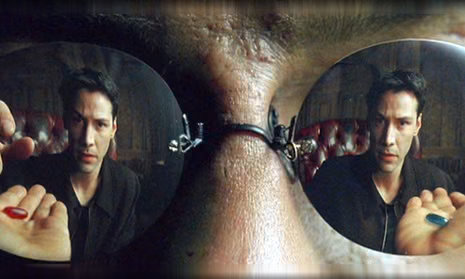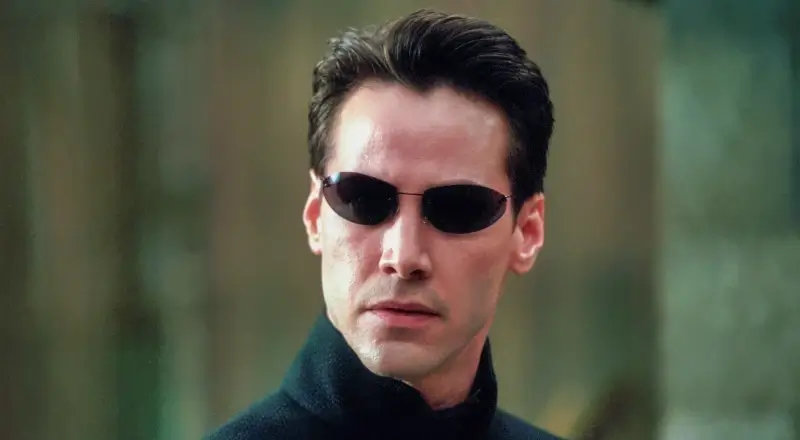When the Wachowskis released The Matrix in 1999, audiences experienced what felt like a revolutionary vision of cinema. The film seemed to emerge fully formed, a groundbreaking masterpiece that had no precedent. Yet the truth is far more fascinating. The Matrix did not arrive out of nowhere. Rather, it represents the culmination of over a century of science fiction literature, philosophy, anime, and cinema, all woven together into a tapestry that would forever change how we think about reality, technology, and human consciousness. To understand The Matrix fully, we must trace its lineage back through time, discovering the works that inspired it and the ideas that shaped its narrative.
The Foundations: When It All Began
The earliest inspiration for The Matrix reaches back to 1865, to Lewis Carroll's Alice in Wonderland. Though written as a children's fantasy, Carroll's masterwork contains profound philosophical elements that would echo through The Matrix more than a century later. In Alice in Wonderland, a young girl tumbles down a rabbit hole and finds herself in a surreal world where logic is inverted, reality is unstable, and nothing operates according to the rules she once understood.
The parallels between Alice's journey and Neo's awakening are striking and intentional. Both protagonists are called into a fantastic world through pursuit of a mysterious figure. Alice follows the white rabbit; Neo is told to "follow the white rabbit" when he sees its tattoo on a stranger's arm. Both enter worlds that challenge their fundamental understanding of reality. Both must navigate bizarre landscapes where the impossible becomes commonplace. Both ultimately discover truths about themselves by transcending the familiar world and questioning their perceptions of what is real.
Carroll's work taught the world that fiction could explore philosophical questions about reality, identity, and existence through vivid imagery and surreal narrative. In many ways, Carroll pioneered the literary tradition that would lead directly to The Matrix. The Wachowskis understood this lineage and incorporated Alice in Wonderland references directly into their film, acknowledging the debt they owed to Carroll's visionary imagination.

The Dystopian Prophets
Moving forward to 1932, we encounter Aldous Huxley's Brave New World, a dystopian novel that presented a chilling vision of technological control and social manipulation. Unlike other dystopias that rely on overt oppression, Huxley's World State maintains control through a more insidious method: pleasure and artificial happiness. The population is genetically engineered into rigid classes, kept docile through a drug called Soma, and prevented from developing critical thinking or emotional depth.
Huxley's central insight was that technology and social engineering could be used to create a prison of contentment. People did not need chains if they were happy enough to never question their chains. This concept directly influenced The Matrix's portrayal of how humanity remains trapped in the simulation. The machines do not need to use brute force to keep humans docile. Instead, they provide a comfortable illusion, a world where people are content enough to never seek the truth.
The connection between Brave New World and The Matrix becomes even clearer when we consider the role of control through technology and the suppression of human freedom and critical inquiry. Both works ask difficult questions: What is happiness worth if it is based on illusion? Is contentment without freedom truly life? These philosophical questions form the emotional and intellectual core of both narratives.
George Orwell's 1984, published in 1949, added another layer to the dystopian tradition that would inform The Matrix. Where Huxley imagined control through pleasure, Orwell imagined control through surveillance and fear. In 1984, Big Brother watches constantly, and even thoughts become subject to government scrutiny. Citizens are subjected to thoughtcrime, doublethink, and constant manipulation of reality itself through the alteration of historical records.
The Matrix borrowed heavily from Orwell's surveillance state. Agents constantly monitor and pursue anyone who threatens the system. Cameras and observation systems pervade the digital world. The system itself watches, controls, and manipulates reality through the simulation. Both Winston Smith in 1984 and Neo in The Matrix emerge as individuals who refuse to accept the reality imposed upon them, who seek truth despite the cost, and who represent humanity's fundamental desire for freedom and authenticity.
The Blurred Boundaries of Reality
In 1968, science fiction author Philip K. Dick published Do Androids Dream of Electric Sheep?, a novel that fundamentally questioned the distinction between human and machine, real and artificial. The novel explores a post-apocalyptic world where artificial beings called androids are nearly indistinguishable from humans. The protagonist, Rick Deckard, must hunt down escaped androids, but the line between hunter and hunted, human and machine, becomes increasingly blurred.
Dick's work opened a philosophical door that would lead directly to The Matrix. If the distinction between human and machine can become indistinguishable, then what does it mean to be human? If our perceptions can be manipulated or if our reality can be artificial, how can we ever be certain of what is real? Do Androids Dream of Electric Sheep? also influenced the film Blade Runner and inspired the television series Westworld, both of which explore similar themes of artificial consciousness and the authenticity of human experience.
In 1969, Dick published another novel that would prove profoundly influential on science fiction and eventually on The Matrix: Ubik. In Ubik, characters find themselves in a reality that is unstable, constantly shifting, and difficult to distinguish from illusion. Time moves backward. Reality warps and changes. The characters must navigate a world where nothing is certain and perception itself becomes unreliable. The novel explores the nature of existence, the reliability of human perception, and the power of consciousness to shape reality.
The connection to The Matrix is evident: both works present worlds where reality is malleable, where characters cannot trust their perceptions, and where the distinction between what is real and what is illusion becomes dangerously blurred. Both works ask their audiences to contemplate the nature of consciousness and to consider whether what we perceive as reality is truly authentic or merely a construct.
Philosophy Meets Cinema
In 1981, French philosopher Jean Baudrillard published Simulacra and Simulation, a philosophical treatise that would prove to be one of the most direct influences on The Matrix. In this work, Baudrillard argues that modern society has become increasingly dominated by simulations and simulacra, copies of copies, representations that have lost all connection to any original reality. He suggests that we no longer interact with reality itself but rather with images, signs, and simulations of reality.
The Matrix took Baudrillard's philosophical concept and made it literal. The digital world of the Matrix is exactly what Baudrillard describes: a perfect simulation, a copy so complete that most inhabitants cannot distinguish it from reality. The green code that represents the Matrix is the visual manifestation of Baudrillard's concept of simulacra. It is representation divorced from reality, a world of pure simulation.
In fact, The Wachowskis included a direct reference to Baudrillard's work in the film. The copy of Simulacra and Simulation that Neo uses to hide his computer disks is a deliberate nod to the philosophical foundation of the movie's themes. Through this small detail, the Wachowskis acknowledged that they were not merely making an action film but rather visualizing complex philosophical concepts about the nature of reality and simulation.
The Cyberpunk Revolution
In 1984, William Gibson published Neuromancer, a science fiction novel that essentially created the cyberpunk genre. Neuromancer follows Case, a washed-up computer hacker who is recruited by a mysterious figure to participate in an ambitious heist within cyberspace. The novel introduced concepts like cyberspace, artificial intelligence, and virtual reality to a wide audience and established many of the aesthetic and thematic elements that would define cyberpunk.
Gibson's Neuromancer influenced The Matrix in several fundamental ways. First, it popularized the concept of cyberspace and virtual reality, making it accessible as a storytelling tool. Second, it established the archetype of the rogue hacker fighting against vast technological systems and artificial intelligences. Neo is essentially a direct descendant of Case, the hacker hero who exists in cyberspace and battles forces far more powerful than himself. Third, Neuromancer presented a world where human consciousness could interface directly with computers, where the boundary between mind and machine was permeable, a concept that The Matrix would explore more thoroughly.

The Anime Influence
If literature and philosophy provided the conceptual foundation for The Matrix, anime provided the visual and stylistic inspiration. In 1988, Katsuhiro Otomo released Akira, a groundbreaking anime film set in the dystopian future city of Neo-Tokyo. Akira combined stunning animation, complex character development, and deep social and political themes into a science fiction epic that redefined what anime could achieve.
Akira explores themes of technological power, governmental control, youth rebellion, and the dangers of unchecked scientific advancement. The protagonist, Tetsuo, develops psychokinetic powers that transform him and ultimately threaten the entire city. His journey of discovery, transformation, and struggle against forces that seek to control him parallels Neo's journey in The Matrix. The visual style of Akira, with its neon colors, dystopian architecture, and dynamic action sequences, directly influenced the aesthetic of The Matrix.
The Wachowskis were serious consumers of anime, and Akira served as a major inspiration for how they envisioned the visual world of The Matrix. The action sequences, the color palette, and the overall sense of a dystopian future dominated by technology all show Akira's influence.
The Direct Predecessors
In 1990, Total Recall brought Philip K. Dick's concepts to the screen. The film, based on Dick's short story "We Can Remember It for You Wholesale," explores the confusion between reality and artificial memory, between authentic experience and implanted illusion. The protagonist must navigate a world where he cannot be certain of what is real and what is false, a concept that would become central to The Matrix.
The Terminator franchise, particularly Terminator 2: Judgment Day released in 1991, presented a world where humanity faces extinction from artificial intelligence and where resistance fighters struggle against overwhelming technological odds. The themes of human versus machine, consciousness versus programming, and the fight for freedom against technological oppression all connect directly to The Matrix.
However, the most direct and acknowledged predecessor to The Matrix was Ghost in the Shell, a Japanese anime film released in 1995 and directed by Mamoru Oshii. The Wachowskis themselves have stated that Ghost in the Shell was their greatest inspiration for The Matrix. Ghost in the Shell follows Major Motoko Kusanagi, a public security agent with a cybernetic body, as she investigates a mysterious hacker and in the process questions her own humanity and the nature of consciousness.
Ghost in the Shell explores artificial intelligence, identity, self-awareness, and the effects of technology on human existence. The film presents a world where the boundary between human and machine has become blurred, where consciousness might exist independently of biological form, and where the nature of identity becomes philosophical rather than merely biological. The visual style, the philosophical questions, the action sequences, and the overall tone of Ghost in the Shell are so similar to The Matrix that one could say The Matrix represents a Western adaptation and expansion of Ghost in the Shell's core themes.
The Synthesis
The genius of the Wachowskis lay not in creating something entirely new but in synthesizing more than a century of storytelling traditions, philosophical inquiry, and artistic vision into a single coherent whole. They took Carroll's surreal awakening, Huxley's technological control, Orwell's surveillance state, Dick's questions about reality and perception, Baudrillard's theory of simulation, Gibson's cyberpunk aesthetics, and anime's visual innovation, and they wove them together into a film that felt revolutionary because it drew upon everything that had come before.
The Matrix succeeded because it honored its influences while creating something genuinely original. It did not merely copy earlier works but rather synthesized their central concerns and questions into a new medium that could address contemporary anxieties about technology, surveillance, identity, and freedom. By the late 1990s, as the internet was transforming society and artificial intelligence was beginning to emerge as a serious field of study, The Matrix arrived at precisely the right moment to capture collective anxieties about the digital age.
The film proved that science fiction was not merely entertainment but a vital way of exploring philosophical questions about the nature of reality, consciousness, and freedom. It demonstrated that cinema could engage with complex philosophical concepts while remaining visually stunning and narratively compelling. Most importantly, it showed that the greatest art often emerges not from isolated genius but from the accumulation and synthesis of creative traditions.
Understanding The Matrix as the culmination of over a century of storytelling tradition deepens our appreciation of the film. It reveals that the questions Neo asks, the world he inhabits, and the journey he undertakes are not merely the inventions of the Wachowskis but rather the latest expressions of humanity's enduring fascination with the nature of reality, the possibilities of technology, and the fundamental human desire for freedom and truth. The Matrix stands as a testament to the power of artistic tradition and the importance of honoring what came before while creating something entirely new.
